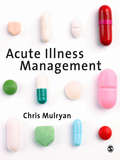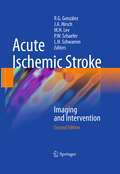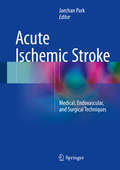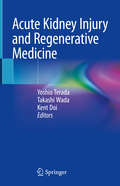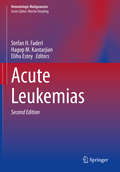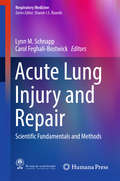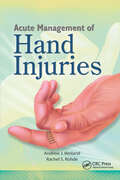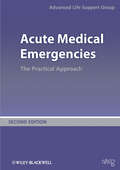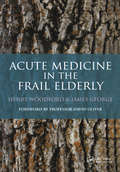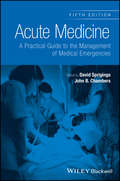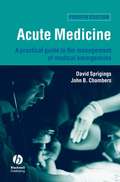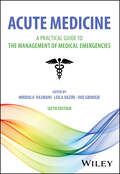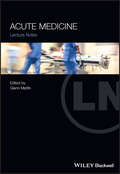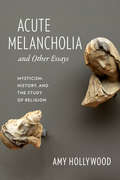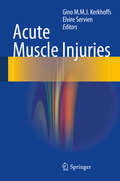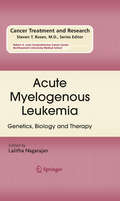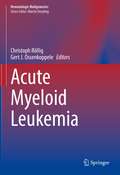- Table View
- List View
Acute Geriatric Care: from Hospital to Territorial Charge
by Nicola Vargas Andrea Fabbo Antonio M EsquinasThis book is focused on geriatric patients in critically ill conditions in the Emergency Room. Their percentage is very high, about 60% of the total percentage of patients, and the availability of intensive care admission is reduced for them as clearly shown during last Covid-19 pandemic. However, the modern approach is not yet able to stop the frailty cascade after hospitalization.In this book authors offer an analysis to overcome this gap. The volume contains two main sections: in the first one, authors discuss recommendations and guidelines for setting organizations and treatment through different case reports of practical management of critically ill geriatric patients (especially patients treated with noninvasive ventilation). In the second part, they analyze the territorial networks that take charge of the older patients. Furthermore, a chapter will be reserved to a comparative investigation of the different types of hospital territorial integration in Europe. The book, written by renowned experts in their fields and by their teams, represents a new tool rich of suggestions for all those physicians involved in the management of this frail population.
Acute Gynaecology and Early Pregnancy
by Davor Jurkovic Roy FarquharsonAcute gynaecological problems are among the most common reasons for women of reproductive age to seek medical help. Emergency outpatient visits now outnumber elective clinical appointments in gynaecology. With a growing number of patients, increasingly complex diagnostic algorithms and a wide range of management options, the participation and training of senior doctors in this field is vital to ensure women receive the best possible treatment. This book provides a thorough overview of acute gynaecology and early pregnancy and has been designed to reflect the syllabus of the RCOG's Advanced Training Skills Module (ATSM) in 'Early pregnancy and emergency gynaecology'. It covers the diagnosis and management of routine clinical problems, such as miscarriage and tubal pregnancy, as well as less frequently seen presentations, such as uncommon forms of ectopic pregnancy and trophoblastic disease. The use of drugs in early pregnancy and management organisational aspects of care are also addressed.
Acute Heart Failure: Putting the Puzzle of Pathophysiology and Evidence Together in Daily Practice
by Wolfgang Krüger<P>Acute heart failure is a potentially life threatening situation where correct, rapid therapy can save lives. Information from the latest research and studies has been used to update this text to bring the latest understanding of the pathophysiology together with a practical guide to diagnosis and management using an evidenced based approach. <P> Since the first edition of Acute Heart Failure, this research has brought to light three important issues to be integrated into a second edition. First, the so-called “vascular heart failure” has been identified as a common and decisive mechanism provoking acute heart failure due to the coupling and interaction between the heart (right and left heart) and the large vessel systems (aorta and pulmonary artery). Second, the interaction and cross-talk between heart and kidneys, the so-called ‘cardiorenal syndrome’ has been identified as another feature of acute heart failure syndromes. Third, we have new knowledge and updated points of views about the development of pulmonary hypertension in patients suffering from heart failure, the group 2 of the classification system of pulmonary hypertension. These are all covered in this second edition. <P> This revision to a seminal text is a valuable addition to any practitioner who treats patients with acute heart failure and wants a deeper understanding of the condition.
Acute Illness Management
by Chris MulryanThe prospect of caring for acutely ill patients has the potential to overwhelm students and newly qualified health professionals, with many reporting feelings of stress, fear and inexperience. In this context, Acute Illness Management arrives as an important and much needed text covering the fundamental aspects of care in the hospital setting. This book is designed to address the student's needs by equipping them with a practical understanding of the essential skills ranging from resuscitation to early intervention and to trauma care. It explains the rationale behind the key protocols of care highlighting the relationship between theory and practice. Key features include: -Up-to-date legal and ethical content. -Tips for analysing care decisions in a critical and effective manner, and -Reflective activities and self-assessment questions to cement learning. Acute Illness Management is an invaluable resource for students and qualified practitioners in nursing and other health professions.
Acute Ischemic Stroke: Imaging and Intervention
by Joshua A. Hirsch Lee H. Schwamm Michael H. Lev Pamela W. Schaefer R. Gilberto GonzálezThis updated second edition of Acute Ischemic Stroke: Imaging and Intervention provides a comprehensive account of the state of the art in the diagnosis and treatment of acute ischemic stroke. The basic format of the first edition has been retained, with sections on fundamentals such as pathophysiology and causes, imaging techniques and interventions. However, each chapter has been revised to reflect the important recent progress in advanced neuroimaging and the use of interventional tools. In addition, a new chapter is included on the classification instruments for ischemic stroke and their use in predicting outcomes and therapeutic triage. All of the authors are internationally recognized experts and members of the interdisciplinary stroke team at the Massachusetts General Hospital and Harvard Medical School. The text is supported by numerous informative illustrations, and ease of reference is ensured through the inclusion of suitable tables. This book will serve as a unique source of up-to-date information for neurologists, emergency physicians, radiologists and other health care providers who care for the patient with acute ischemic stroke.
Acute Ischemic Stroke: Medical, Endovascular, and Surgical Techniques
by Jaechan ParkThisbook approaches the topic of management of acute ischemic stroke in aninterdisciplinary manner, explaining how best to utilize the methods currentlyavailable for medical, surgical, and endovascular care. After anopening section on basics such as pathophysiology, radiological assessment, andpathology, comprehensive and up-to-date information is provided on each of the availabletherapies, techniques, and practices. Special attention is paid to recent advancesin neurointerventional and neurosurgical procedures, with clear description ofimportant technical details. The book includes plentiful high-quality caseillustrations and a wealth of practical information thatwill prove of value in emergency rooms, angiography suites, operating rooms,and intensive care units. It will aid not only neurologists,neurointerventionists, and neurosurgeons, but also all others who are involvedin the management of acute ischemic stroke, from radiologists and emergencyphysicians to healthcare providers.
Acute Kidney Injury and Regenerative Medicine
by Yoshio Terada Takashi Wada Kent DoiThis book presents up-to-date information on the clinical-pathophysiological features of acute renal injury and discusses the KDIGO diagnostic criteria, as well as novel experimental findings, including in the area of regenerative medicine. It also highlights the clinical-pathophysiological importance of AKI in clinical settings, including differential diagnoses and management of AKI. In the past, the pathology associated with sudden renal impairment was characterized as acute renal failure (ARF). However, in the 2000s, the joint efforts of specialists in fields including nephrology, intensive care medicine, and cardiovascular medicine led to the introduction of a novel concept known as acute kidney injury (AKI). As medical care progressed, patients such as high-risk elderly subjects who were not deemed to be candidates for invasive therapy came to be treated in intensive care units (ICUs). As a result, kidney injury as a subset of multiple organ failure was re-considered as AKI, especially in intensive care medicine. AKI was then proposed as a novel disease concept to emphasize the importance of early diagnosis and early intervention to improve prognosis.Presenting novel features, such as the definition of AKI, risk factors and management; biomarkers, such as neutrophil gelatinase-associated lipocalin (NGAL) and L-type fatty acid-binding protein (L-FABP); long-term outcomes of AKI; as well as renal regeneration using iPS cell, manipulation of embryonic genes, and Xenotransplanted embryonic kidney, this book is of interest to all physicians and researchers in this field around the globe.
Acute Leukemias (Hematologic Malignancies)
by Hagop M. Kantarjian Stefan H. Faderl Elihu EsteyBetter therapy of acute leukemias depends ultimately on better understanding of the distinction between leukemic and normal progenitor cells. This hugely important new book describes the current knowledge of acute leukemia biology and discusses new classification systems that have arisen as a result of emerging insights into pathogenesis. Estey, Faderl and Kantarjian, who all work at the respected Anderson Cancer Center in Houston, Texas, USA, examine in detail advances in the treatment of particular types of acute leukemia. Their book also covers the management of acute leukemia in general as well as the development of new therapies. This book will be extremely useful to clinicians.
Acute Lung Injury and Repair: Scientific Fundamentals and Methods (Respiratory Medicine)
by Lynn M. Schnapp Carol Feghali-BostwickAcute Respiratory Distress Syndrome (ARDS) remains an important cause of morbidity and mortality worldwide, and the incidence is predicted to increase with the aging population Several clinical disorders can initiate ARDS, including pneumonia, sepsis, gastric aspiration and trauma but despite intense research over the past 40 years, we still have an incomplete understanding of the pathophysiology of the disease and treatment remains largely supportive. This book provides an overview of acute lung injury and repair, describes current animal models to study lung injury and reviews current methodologies to study and measure lung injury and repair. Special emphasis is given to state of the art techniques and methods and relevance to human disease. Acute Lung Injury and Repair: Scientific Fundamentals and Methods is a useful resource for physicians and scientists who are interested in experimental model systems for insight into ARDS pathogenesis and treatment strategies.
Acute Lymphoblastic Leukemia in Children and Adolescents (Pediatric Oncology)
by Gabriele Escherich Valentino ConterThis book is a comprehensive and up-to-date compendium on diagnosis, treatment and late effects of Acute Lymphoblastic Leukemia (ALL) in children, adolescents and young adults. After introductory chapters on the epidemiology and biology of ALL, treatment considerations are extensively reviewed, also with emphasis on special patient groups, such as Infants, Adolescents and patients with Down Syndrome. Immunotherapy in Acute Lymphoblastic Leukemia is reviewed as well as strategies for patients with Lymphoblastic Lymphoma and for patients with refractory or relapsed ALL. The authors are internationally recognized experts and offer up-to-date insights on etiology, biology, and treatment. This book will prove indispensable for those treating or researching into this disease.
Acute Management of Hand Injuries
by Andrew Weiland Rachel RohdeDo you encounter patients with hand and wrist problems? Are there times when you wish you had a hand surgeon next to you to help guide you in the right direction? The answers you are looking for can be found inside Acute Management of Hand Injuries by hand surgeons, Drs. Andrew J. Weiland and Rachel S. Rohde.Acute Management of Hand Injuries is a concise and user-friendly book including the most common acute hand and wrist complaints including fractures, dislocations, tendon and nerve injuries, infections, bite injuries, and industrial trauma. This book acts as a “pocket consultant” for non-hand specialists who temporize acute hand issues before referring the patient to a specialist.Acute Management of Hand Injuries is designed to provide the most current and up-to-date information on even the smallest hand afflictions.Inside You’ll Also Find: • Numerous photographs and radiographs • Hand evaluation diagram template • Suggested readings at the end of each chapter • Quick reference appendices covering topics such as antibiotic recommendations and burn treatmentAcute Management of Hand Injuries also will serve as a perfect introductory guide for residents and students in orthopedic or plastic surgery programs who will be expected to master these basic principles.Each Chapter Includes: • Mechanism of Injury • Evaluation • Acute Treatment • Definitive Treatment • Potential ProblemsAcute Management of Hand Injuries is ideal for orthopedic surgeons, physicians, physician assistants, nurse practitioners, residents, occupational therapists, physical therapists, and all who provide care in emergency room, urgent care, and primary practice settings.
Acute Medical Emergencies
by Advanced Life Support GroupAcute Medical Emergencies is based on the popular Advanced Life Support Group course MedicALS (Medical Advanced Life Support) and is an invaluable resource for all doctors dealing with medical emergencies.This comprehensive guide deals with the medical aspects of diagnosis and treatment of acute emergencies. Its structured approach teaches the novice how to assess and recognise a patient in an acute condition, and how to interpret vital symptoms such as breathlessness and chest or abdominal pain.There are separate sections on interpretation of investigations, and procedures for managing the emergency. It covers procedures for acute emergencies occurring anywhere - on hospital wards or beyond. The clarity of the text, including simple line illustrations, ensure its tried and tested procedures provide clear, concise advice on recognition and management of medical emergencies.
Acute Medicine
by Chris RoseveareAcute Medicine is the central part of foundation and specialist general medical training and is one of the most rapidly expanding UK hospital specialties. Acute Medicine: Clinical Cases Uncovered combines patient cases and outcomes, drawn from real-life experiences, with reference to the curriculum for Training in General (Acute) Medicine. It provides self-assessment MCQs, EMQs and SAQs to give medical students, junior doctors, nurses and allied healthcare professionals the perfect preparation for life on the wards.
Acute Medicine
by Stephen Haydock Duncan Whitehead Zoë Fritz Stephen Haydock Duncan WhiteheadThis practical book describes the basic science, clinical presentation and management of the 67 common acute medical presentations stipulated in the Royal College of Physicians syllabus for Core Medical Training and Acute Core Common Stem. • Case scenarios are included for each presentation, and guidance about management is offered in the context of national guidelines and important studies • Experienced clinicians describe their approach to common difficult problems and explain the answers to questions often asked on the ward round by successive generations of trainees • Chapters highlight key decisions that need to be made early, common misunderstandings, and risks • Detailed discussion provides an understanding of the rationale, allowing the reader to apply their knowledge to other situations • Guidance is provided on urgency of referral, safe ambulatory management, and when to seek specialist help. This is an essential resource that provides readers with the knowledge base to practise as a confident medical registrar.
Acute Medicine
by J. F. CadeUncommon problems tend to be overlooked; they are usually difficult to diagnose and a challenge to manage. Acute Medicine: Uncommon Problems and Challenges gathers together all uncommon problems relevant to the treatment of seriously ill patients in a quick one-stop reference. Each topic contains both essential diagnostic and treatment information and discusses the implications for intensive care management, obviating the need to refer to specialized sources. The A-Z format with frequent cross-referencing aids rapid access to key information and cartoons throughout aid learning. Intensivists, anaesthetists, emergency specialists and a wide range of other healthcare professionals will find this an invaluable resource when faced with acute medical problems. From Abruptio placentae to Zollinger-Ellison syndrome, Acute Medicine: Uncommon Problems and Challenges will help you diagnose and manage the tricky acute problems you encounter in daily clinical practice.
Acute Medicine in the Frail Elderly
by James George Henry WoodfordFrail older people now contribute the majority of the acute emergency take both medical and surgical. Despite this there is often a lack of confidence and knowledge among doctors and nurses in treating older people in the Emergency Department and on Emergency Assessment Units.From the Preface Emergency care of frail older people is challenging but very rewarding. Older patients tend to be complex and therefore their assessment needs to be more extensive and include comprehensive geriatric assessment. It is the extras in their assessment that are not usually needed in younger patients, such as cognitive, functional and social evaluations that make the difference in achieving a better outcome. This book describes the key features of high quality care for frail elderly patients in acute hospital settings. With chapters on assessment and the characteristic non-specific ways that patients tend to present (such as 'confusion', 'collapse query cause' and 'off legs'), this practical guide is ideal to have on-hand. As well as common medical and surgical conditions, it also covers medication management, elder abuse, pressure ulcers and hypothermia, including the physiological changes seen in ageing and ways to define frail patients. Tables, diagrams and images are ideal for quick reference, and key points are summarised throughout the text to aid comprehension, providing doctors, nurses and therapists with both background and essential information to provide the excellent acute care older people deserve.
Acute Medicine: A Practical Guide to the Management of Medical Emergencies
by David C. Sprigings John B. ChambersAcute Medicine offers an accessible and concise guide to the practical management of all acute medical problems likely to be encountered in the emergency department, ambulatory care centre, acute medical unit or on the wards. Reflecting the maturation of acute medicine as a separate specialty, the book is divided into common presentations, specific problems and procedures. New to the fifth edition is a chapter on bed-side ultrasonography; throughout, emphasis is placed on patient safety, and the use of flow diagrams, tables and figures ensures that key information is quickly accessible. Thoroughly revised by experts in the subject, and updated to reflect current approaches to diagnosis and management, Acute Medicine is an excellent companion for the trainee as well as an aide-mémoire for the more experienced physician.
Acute Medicine: A Practical Guide to the Management of Medical Emergencies
by David C. Sprigings John B. ChambersThis extremely popular title has become the definitive pocket guide to the management of medical emergencies for front-line hospital doctors. It provides detailed guidance on the diagnosis and treatment of all common conditions and includes a step-by-step guide to the nine most important practical procedures in acute medicine.
Acute Medicine: A Practical Guide to the Management of Medical Emergencies
by Mridula Rajwani Leila Vaziri Ivie GbinigieRevised edition of a leading educational resource on acute medicine, updated with existing guidance and new, exciting areas of research Acute Medicine is a quick reference guide that details a comprehensive range of acute medical emergencies affecting different organ systems with the latest guidelines and evidence for management of these emergencies. It includes discussions around location of care, including principles of ambulatory care or same day emergency care and the different services that are in place to provide acute care within the community (e.g. hospital at home). The book adopts a unique approach to clinical assessment by outlining key priorities during acute critical periods, along with ongoing management considerations after diagnosis and initial treatment. This new edition covers the latest research and applications in this rapidly developing field, such as point-of-care ultrasound, its role in frontline medicine, and its use in clinical assessment. Contributed to by experts in their fields sharing the latest and ground-breaking best clinical practice, Acute Medicine includes information on: Hypotension and shock, reduced consciousness level, delirium, and falls in older people Acute chest pain, palpitations, transient loss of consciousness, acute breathlessness and respiratory failure, and pleural effusion Acute headaches, seizures and epilepsy, weakness and paralysis, acute sensory symptoms, and loss of vision Acute upper and lower gastrointestinal bleeding, alcoholic hepatitis, urinary tract infections, and acute liver failure Cellulitis and necrotizing fasciitis, erythroderma and toxic epidermal necrolysis, septic arthritis, acute vasculitis, and acute gout and pseudogout Acute Medicine serves as an excellent one-stop reference for practitioners in the field, physicians, residents, nurses, nurse practitioners, physician associates, and many more. It may also be used as a revision aid for those in undergraduate or postgraduate education.
Acute Medicine: Lecture Notes (Lecture Notes)
by Glenn MatfinLecture Notes discusses the principles of the initial assessment, investigation, diagnosis, and management of adult patients with everyday Acute Internal Medicine (AIM) presentations and conditions. This textbook is wide in scope and covers topics ranging from initial identification of acute medical illness, through to effective discharge planning. Lecture Notes contains the latest developments on the generic professional and specialty specific capabilities needed to manage patients presenting with a wide range of medical symptoms and conditions covered in the UK AIM curriculum (2022). In Lecture Notes, readers can expect to find detailed information on: Generic skills relevant to AIM, such as clinical reasoning, safe prescribing, point of care ultrasound (POCUS), resuscitation, and managing the acute medical take AIM across the various acute care settings – home (telemedicine, virtual wards, Hospital at Home), ambulatory (same day emergency care), and in-hospital (acute medical unit, enhanced care, critical care) AIM presentations and conditions in special populations such as older people, pregnancy, people with HIV, LGBTQ+, inclusion medicine, people with learning disabilities, perioperative medicine, people with mental illness and more Common presentations in AIM Standalone chapters can be read in any sequence, making the text perfect for quick referenceWith its accessible coverage of a wide range of AIM content, Lecture Notes: Acute Medicine is an essential resource for medical students, physician trainees, consultants, and other members of the multidisciplinary team working in acute care, patient-facing settings.
Acute Melancholia and Other Essays: Mysticism, History, and the Study of Religion (Gender, Theory, and Religion)
by Amy HollywoodAcute Melancholia and Other Essays deploys spirited and progressive approaches to the study of Christian mysticism and the philosophy of religion. Ideal for novices and experienced scholars alike, the volume makes a forceful case for thinking about religion as both belief and practice, in which traditions marked by change are passed down through generations, laying the groundwork for their own critique. Through a provocative integration of medieval sources and texts by Jacques Derrida, Judith Butler, Talal Asad, and Dipesh Chakrabarty, this book redefines what it means to engage critically with history and those embedded within it.
Acute Mental Health Nursing: From Acute Concerns to the Capable Practitioner
by Damian Mitchell Dr David Howard Marc Harrison'This is an exciting and timely contribution to the resources available for policy makers, and practitioners wishing to improve standards and health and social outcomes in inpatient care within the context of community oriented comprehensive care for people with mental illness' - Professor Rachel Jenkins, Director, WHO Collaborating Centre, Institute of Psychiatry, Kings College London 'This book is a valuable addition to the growing literature on acute care and should provide great encouragement to the frontline staff in this area... By bringing together this range of excellent material the editors have also been able to produce a book which addresses the most thorny problems which face most frontline staff for much of their working day' - From the Foreword by Professor Kevin Gournay, CBE Health Services Research Department, Institute of Psychiatry 'Inpatient mental health care has had a rough ride in recent years. Its shortcomings have been highlighted, while policy emphasis and cash have been directed to community services. This very welcome book reminds us that inpatient care and treatment are an essential element in the spectrum of mental health services and shows how they can be re-thought and fine-tuned in ethos, practice and training, for the benefit of service-users, staff and the wider community. It deserves a wide readership' - John Bowis MEP (former Health Minister for Mental Health) 'By concentrating on describing the skills of practitioners the editors and authors of Acute Mental Health Nursing have developed a unique resource for both students and practitioners of acute inpatient care. Their no nonsense evidence- based approach will be an invaluable aid to developing practical responses to this important though challenging area of mental health practice' - Richard Bradshaw, Director of Nursing Prison Health Department of Health England formerly Professional Office Mental Health and Learning Disabilities Nursing UKCC 'Comprehensively tackles a range of key issues that the student or advanced practitioner in acute mental health nursing will face... I recommend this book, which will provide a useful resource for anyone interested in this important area of nursing' - Journal of Community Nursing Recent mental health policy has focused on developing community-based services, while the reality remains that patients experiencing acute episodes of illness are mainly cared for in hospital. Acute Mental Health Nursing has been developed as a guide to the core knowledge and skills required for working in inpatient settings. Bringing together a vastly experienced and multi-professional team of contributors, the book covers core areas of practice including: · assessment · risk management · case management and integrated care pathways · observation · cognitive behavioural therapy · psycho-social interventions · medication management · user involvement · social inclusion · measurement of health and social functioning. Drawing on the latest developments in policy and planning, Acute Mental Health Nursing addresses issues which are specific to working in inpatient settings. It has been designed for use in training and is also an excellent source of reference for use in practice.
Acute Muscle Injuries
by Gino M. M. J. Kerkhoffs Elvire ServienThis book documents current knowledge and standards of care for acute muscle injuries. The full range of injuries is covered, including those to the hamstring, hip adductor, quadriceps, calf, pectoralis major, biceps brachii, latissimus dorsi and rectus abdominis muscles. Evidence-based content is combined with experience from medical experts from around the globe in order to provide the reader with a full picture of the latest insights into terminology, trauma mechanisms, basic principles of healing, diagnosis and treatment. Helpful diagnostic and treatment algorithms are included and clear guidance provided on ensuring optimal rehabilitation and rapid return to sports. The book is structured in such a way that it will serve as an ideal reference manual for orthopaedic surgeons, sports medicine physicians, physiotherapists, general practitioners, paramedics, sports managers, athletes and coaches.
Acute Myelogenous Leukemia: Genetics, Biology and Therapy (Cancer Treatment and Research #145)
by Lalitha NagarajanAcute myelogenous leukemia (AML), is the most common form of leukemia in adults. AML is a deadly form of malignancy, the prognosis for which has not improved in the last two decades. More importantly, it is a malignancy that is seen in older adults, therefore the number of cases is likely to rise as the population ages. Over the past 15 years, genetic mechanisms underlying AML have begun to unfold. Additional research in this area has helped identify key components and characteristics. Consequently, targeted therapy of AML is receiving much attention. It is the hope of researchers that as with chronic myelogenous leukemia (CML), and the drug, Gleevec, a targeted therapy for AML will be discovered.
Acute Myeloid Leukemia (Hematologic Malignancies)
by Christoph Röllig Gert J. OssenkoppeleThis book, written by a team of leading experts, provides a comprehensive overview of acute myeloid leukemia (AML), the most frequent acute leukemia in adults. The opening chapters present current knowledge of epidemiology, etiologic factors, and the pathogenesis and molecular development of AML. Detailed guidance is offered on laboratory and clinical diagnostic workup and disease classification, and the patient- and disease-related factors that determine prognosis and treatment allocation are identified. On the basis of these general considerations, initial treatments in patients considered fit for intensive treatment and in older and co-morbid patients are reviewed, and the available relapse treatment strategies, explained. For all clinical scenarios, the most recent data on the optimal use of newly approved agents in different AML subgroups are presented. Separate chapters address the treatment of acute promyelocytic leukemia, current practice of allogeneic stem cell transplantation, and special clinical situations. Finally, promising approaches in drug development, current standards and challenges in assessment of measurable residual disease, immune approaches, and ideas for innovative trial designs are considered.



